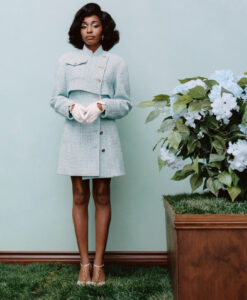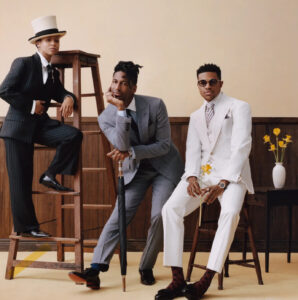
Each spring, the Met Gala arrives like a sartorial oracle—an evening where fashion, fantasy, and cultural symbolism converge beneath the storied arches of the Metropolitan Museum of Art. But behind the glitter and custom couture lies a far more serious proposition: the annual theme is never arbitrary. It is a prompt, a provocation, and a mirror. This year’s theme, “The Garden of Time”, is anchored in ideas of temporality, elegance, and rebellion. Its most potent undercurrent? A revival of dandyism—a centuries-old style ethos reinterpreted through a distinctly modern and Black cultural lens.
Historically, dandyism was more than a mode of dress—it was a language of refinement wielded against rigidity. In the 19th century, Beau Brummell made simplicity radical, subverting the excess of courtly fashion with meticulous, understated elegance. Over time, the dandy became a figure of cultural contradiction: at once flamboyant and restrained, masculine and effeminate, aristocratic and oppositional. But it was within Black diasporic culture that dandyism evolved into something far more subversive—a form of style protest, a weapon of dignity, and a reclamation of identity.
This year, the Met Gala is not just showcasing fashion’s past—it is interrogating how elegance has been racialized, feminized, and politicized across history. And through this lens, the 2025 theme becomes more than a costume directive. It becomes a narrative device—one that tells a centuries-spanning story of visibility, resistance, and reinvention.
Dandyism: From Brummell to Harlem
To understand the full magnitude of this year’s Met theme, one must trace dandyism back to its roots. In 18th-century Britain, Beau Brummell made a name for himself by rejecting powdered wigs and embroidered silks in favor of perfectly tailored, understated clothing. His aesthetic philosophy valued cleanliness, silhouette, and poise—concepts that would eventually influence the modern suit.
But dandyism was never just about fashion—it was a philosophy. The dandy’s immaculate dress masked a deeper rebellion against social conformity, class structure, and prescribed gender roles. By emphasizing performance over pedigree, the dandy blurred the lines between aristocrat and aesthete, identity and illusion.
When this ethos was adopted and redefined by Black culture—particularly in Harlem during the 20th century—it gained radical political weight. In the midst of systemic racism and economic marginalization, sartorial elegance became a form of protest. To dress impeccably, to adorn oneself in fine tailoring, was to defy the stereotypes of subservience and inferiority.
The Harlem dandy did not merely wear suits; he adorned himself with pride. He reconfigured the European sartorial canon through the lens of Black creativity, confidence, and defiance. Zoot suits, wide-brimmed hats, and high-waisted trousers weren’t just stylish—they were subversive.
Dapper Dan: The Tailor Who Rewrote Luxury
No one embodies the modern legacy of dandyism more vividly than Dapper Dan, the Harlem-based designer whose work redefined luxury for an entire generation. In the 1980s and ’90s, Dan became infamous for repurposing luxury logos—Gucci, Louis Vuitton, Fendi—and printing them onto custom garments worn by hip-hop royalty and neighborhood legends alike.
What Dan did was radical. He took the emblems of exclusivity and rewrote them in the language of the street. His designs fused classical tailoring with the audacity of rap culture, creating a new visual lexicon of Black opulence. The traditional dandy’s concern with refinement found its echo in Dan’s obsession with detail, fit, and flamboyance—but his purpose was different. He wasn’t dressing to assimilate into aristocracy. He was declaring that Blackness itself was luxury.
Dan’s eventual reconciliation with the fashion world—after years of being dismissed and sued by the very houses he bootlegged—has become one of fashion’s most ironic full-circle stories. Now, he designs officially for Gucci, bringing his original vision to couture runways and Met Gala carpets.
It’s only fitting, then, that his influence looms large over this year’s Met theme. Dandyism in 2025 is not just about the return of cravats or frock coats—it’s about understanding how the very idea of elegance has been reclaimed, reauthored, and politicized by figures like Dapper Dan.
Genderplay and Tailoring: The Evolution Continues
This year’s Met Gala is also situated in a cultural moment where gender expression in fashion has never been more expansive. The traditional dandy—a man who borrowed femininity to disrupt patriarchal codes—has given way to a broader spectrum of gender-defiant style. And on this front, the Met’s red carpet has long served as a proving ground.
The influence of designers like Anthony Vaccarello at Saint Laurent is key to understanding the current aesthetic climate. His SS25 collection featured female models in sharply tailored menswear silhouettes—wide shoulders, razor-sharp lapels, unbuttoned silk shirts. These looks were not drag, nor parody, but fluid interpretations of elegance. They asked: What if the dandy wasn’t just a man in women’s flair, but a woman redefining masculinity?
Figures like Zendaya and Janelle Monáe have long played in this terrain, appearing in tuxedos that aren’t feminized but rather, radically owned. Their looks for this year’s Gala are anticipated as more than just glamorous—they’re statements. In a fashion world that has so long policed who gets to be “elegant,” their presence subverts and transcends.
Meanwhile, men are increasingly embracing softness: silk blouses, brooches, painted nails, pastel tailoring. A$AP Rocky, a perennial Met Gala figure, has become the poster child for this shift. His ability to juxtapose pearl hair clips with razor-sharp blazers or wear Saint Laurent suiting with streetwear élan positions him as a 21st-century dandy—part Brummell, part Basquiat.
Law Roach and the Styling of Subversion
The rise of stylists as auteurs in their own right is another crucial aspect of this year’s theme, and none has reshaped the fashion vernacular quite like Law Roach. Known for his meticulous styling of Zendaya, Megan Thee Stallion, and Anya Taylor-Joy, Roach has turned red carpet dressing into visual historiography.
Roach understands that fashion isn’t merely surface—it’s semiotics. His looks often quote from vintage runway shows, cinematic characters, and archival couture. When Zendaya wore a Joan of Arc–inspired Versace gown at the 2018 Met Gala, she was not just embodying a theme—she was asserting a cultural narrative.
For this year’s theme, Roach’s hand is unmistakable. His embrace of sharp tailoring, rich brocades, and historical silhouettes—often with a twist of sci-fi or surrealism—turns the carpet into both a tribute and a reinterpretation. He recognizes the dandy not as a costume but as a cipher—one through which to tell deeper stories about identity, freedom, and play.
Fashion History Rewritten: The Broader Implications
This year’s Met Gala theme does not exist in isolation—it speaks to broader shifts in the way fashion history is being written, taught, and remembered. The canon is being reexamined, and once-marginalized aesthetics are finally entering the museum’s halls and fashion’s main stages.
For decades, fashion history was white, Eurocentric, and male. The Black dandy, the street tailor, the self-taught stylist—all were seen as peripheral. But as the Met’s curatorial direction shifts toward a more inclusive and intersectional lens, these figures are being rightly recognized as central. This year’s exhibition promises to highlight these counter-histories, displaying garments, portraits, and archival material that challenge the established narrative.
By centering the dandy, the Gala reframes elegance not as inherited, but as constructed, contested, and reclaimed. It suggests that style is not simply about taste, but about authorship. Who gets to be considered refined? Who gets to redefine beauty?
Impression
“The Garden of Time,” as a metaphor, is brilliant. It suggests that style is not linear but cyclical, organic, seasonal. This year’s Met Gala theme, with its dandy core and Black cultural lens, asks us to walk through this garden—not just to admire the flowers, but to see which ones were nearly left out of the archive.
Dandyism today is not nostalgia. It is not cosplay. It is not about returning to a purer aesthetic era. Rather, it is a radical continuance—an insistence that elegance belongs to everyone, especially to those who’ve been historically denied it. In the hands of Black designers, stylists, and cultural figures, the dandy becomes not a relic, but a resurrection.
And in the flicker of camera flashes on the Met steps, in the tailored lapels and silk linings, one can almost hear the echo: fashion, like time, is a garden. And every dandy, past and present, has planted a seed.
No comments yet.








